Prepping for winter: Take this mulch IQ test
Published 3:00 am Sunday, November 6, 2022

- Test your mulch IQ with Liz Douville's quiz.
You have to admit that we may have been in denial that winter weather was so close. If you were caught in the mind-muddle of what to do next, take the fall IQ test. It will help establish the to-do list, if too late for this year, add the reminders to your garden journal.
What’s the best way to mulch fall-planted perennials?
A) Add a thick layer of mulch.
B) Mulch after the first frost.
C) Wait until the ground freezes.
Wait. Cover them too early and they won’t have a chance to harden off slowly to the colder temperatures. It’s not necessarily the cold that damages vulnerable plants, it’s the cold/warm/cold cycles that sometimes happen in winter. Wait until the soil is good and cold, soil temperature should be 50 degrees F, then mulch. When you start to see new growth next year, pull the mulch back so your perennials don’t have to fight their way through the cover. Make sure you have a backup plan for quick cover if a late spring frost is forecast.
How should you tackle the leaves that have fallen?
A) Rake every last one up as soon as you can.
B) Rake them off your lawn.
C) Leave them alone.
Rake them off your lawn. Large leaves, like maples, should come off the lawn because they can suffocate the grass over the winter. Small-leafed trees, such as ash, aspen or crabapple aren’t as big a worry. Their leaves will probably break down before they have a chance to smother anything.
How can you make sure your lawn looks passable without putting much effort into it?
A) Stick with the established program of feeding early spring, early summer, late summer and late fall.
B) Put down a slow-release fertilizer once a year in fall and let it do its work all year.
C) Feed in late spring and summer.
B is the answer that requires less work. The best care is establishing a year round schedule if possible. There is a difference between cool-season and warm-season grasses. Kentucky blue and fescues, generally what we grow in our climate, stop growing but don’t turn completely brown in winter. Warm-season grasses are common in the South. They turn a straw color in winter.
The tree is successfully planted. Should you mulch it in?
A) No, it wasn’t mulched in the container.
B) Yes, pile it up around the collar to protect the trunk and roots.
C) Yes, spread a layer over the roots.
C is the best answer. A 2- to 4-inch layer of organic mulch spread over the trees’ root is plenty to keep roots insulated from the freeze-thaw cycle that damages plant roots. Be sure to start about 6 inches away from the tree’s trunk so you don’t attract rodents and insect damage. If you have voles you may consider skipping the mulch altogether — they love to tunnel in soft mulch.
Bulb food
Bone meal used to be a common bulb food, but now there are more options. We have learned that the bone meal seems to attract rodents and digging dogs. We have also learned that bone meal only contains phosphorous and not any other nutrients that the bulbs need.
Putting fertilizer in the hole with the bulb can be risky because there is a chance the fertilizer could burn the roots. The most earth-friendly way to feed perennial bulbs is to topdress with compost in fall and spring.
If your flowers aren’t blooming like they should, you might want to put a slow-release bulb fertilizer on top of the soil in fall. That’s when the roots are most actively taking up nutrients. And remember, in the spring after the bloom, do not cut back the foliage.
Winter dehydration is a problem in our climate. We can’t count on a good snow cover to provide the moisture. Keep the watering can handy to be used if necessary, especially if you value any new fall planting. A reminder — if you are using a hose, be sure to disconnect from an outdoor spigot after each use.








